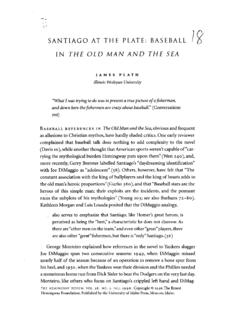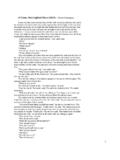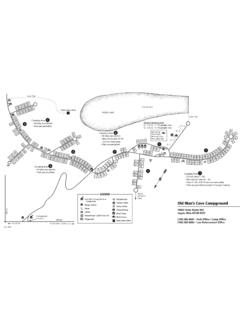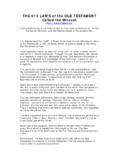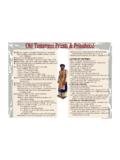Transcription of ATLS: Pretests A 22 year old man is hypotensive and ...
1 1 ATLS: Pretests1. Thoracic trauma. Chest tube 22 year old man is hypotensive and tachycardic after a shotgun wound to the left blood after initial IV fluid resuscitation, a closed tube thoracostomy is performed fordecreased left breath soundsa) reexamine the chestb) perform an aortogramc) obtain a CT scan of the chestd) obtain arterial blood gas analysese) perform tranesohageal echocardiographyanswer: : chest tube insertion, p. Musculoskeletal trauma. Extremity construction worker falls two stories from a building and sustains bilateral calcanealfractures. In the emergency department, he is alert, vital signs are normal, and he iscomplaining of severe pain in both heels and his lower back. Lower extremity pulses arestrong and there is no other deformity. The suspected diagnosis is most likely to be confirmedbya) angiographyb) compartment pressuresc) retrograde urethrogramd) Doppler-ultrasound studiese) complete spine x-ray seriesanswer: Trauma in the third trimester of pregnancy, all of the following changes occur normally EXCEPTaa) decrease in PaCO2b) decrease in leukocyte countc) reduced gastric emptying rated) diminished residual lung volumee) diminished elvic ligament tensionanswer: : p.
2 Head managing the head injured patient, the most important initial step is toa) secure the airwayb) obtain c-spine filmc) support circulationc) control scalp hemorrhagee) determine the GCS scoreanswer: : p. previously healthy, 70kg (154 pound) man suffers an estimated acute blood loss of 2 one of the following statements applies to this patient?a) his pulse pressure will be widenedb) his urinary output will be at the lower limits of normalc) he will have tachycardia, but no change in his systolic blood pressured) his systolic blood pressure will be decreased with a narrowed pulse ressure (true)e) his systolic blood pressure will be maintained with an elevated diastolic pressureanswer: : p. Trauma in physiologic hypervolemia of pregnancy has clinical significance in the management ofthe severely injured, gravid woman bya) reducing the need for blood transfusionb) increasing the risk of pulmonary edemac) complicating the management of closed head injuryd) reducing the volume of crystalloid required for resuscitatione) increasing the volume of blood loss toproduce maternal hypotensionanswer: : p.
3 Thermal Injuries. Injury Due to Burn and best guide for adequate fluid resuscitation of the burn patient is3a) adequate urinary outputb) reversal of systemic acidosisc) normalization of the heart rated) a normal central venous pressuree) 4mL/kg/percent body burn/24 hoursanswer: : p. a diagnosis of shock must includea) hypoxemiab) acidosisc) hypotensiond) increased vascular resistancee) evidence of inadequate organ perfusionanswer: : p. Musculoskeletal trauma. Extremity 7 year old boy is brought to the emergency department by his parents several minutes afterhe fell through a window. He is bleeding profusely from a 6-cm wound of his medial rightthigh. Immediate management of the wound should consist ofa) application of a tourniquetb) direct pressure on the woundc) packing the wound with gauzed) direct pressure on the femoral artery at the groine) debridement of devitalized tissueanswer: binfo: p.
4 Head the patient with severe traumatic brain injury, profound hypocarbia should be avoided topreventa) respiratory alkalosisb) metabolic acidosisc) cerebral vasoconstriction with diminished perfusiond) neurogenic pulmonary edema4e) shift of the oxyhemoglobin dissociation curveanswer: cinfo: p. 136, dioxide is perhaps the most potent available modulator of cerebrovascular tone andthus cerebral blood flow (CBF). Hypercarbia and hypoxia are both potent cerebral vasodilatorsthat result in increased cerebral blood flow and volume and, potentially, increased ICP; thus,they must be avoided. Orotracheal intubation allows for airway protection in patients who areseverely obtunded and allows for better control ofoxygenation and Abdominal 25 year old man is brought to a hospital with a general surgeon after being involved in amotor vehicle crash. He has a GCS of 13 and complains of abdominal pain.
5 His bloodpressure was 80 mm Hg systolic by palpation on arrival at the hospital, but increases to110/70 mm Hg with the administration of 2 liters of intravenous fluid. His heart rate remains120 beats per minute. Computed tomography shows an aortic injury and splenic lacerationwith free abdominal fluid. His blood pressure falls to 70 mm Hg after CT. The next step isa) contrast angiographyb) transfer to higher level trauma centerc) exploratory laparotomyd) transfuse packed red blood cellse) transesophageal echocardiographyanswer: : p. Which one of the following statements regarding abdominal trauma in the pregnant patientis true?a) the fetus is in jeopardy only with major abdominal traumab) leakage of amniotic fluid is an indication for hospital admissionc) indications for peritoneal lavage are different from those in the nonpregnant patientd) penetration of an abdominal hollow viscus is more common in late than in early pregnancye) the secondary survey follows a different pattern from that of the nonpregnant patientanswer: : p.
6 Thoracic first maneuver to improve oxygenation after chest injury is5a) intubate the patientb) assess arterial blood gasesc) administer supplemental oxygend) ascertain the need for a chest tubee) obtain a chest x-rayanswer: Head 25 year old man , injured in a motor vehicular crash, is admitted to the emergencydepartment. His pupils react sluggishly and his eyes open to painful stimuli. He does notfollow commands, but he does moan periodically. His right arm is deformed and does notrespond to painful stimulus; however, his left hand reaches purposefully toward the painfulstimulus. Both legs are stiffly extended. His GCS Score isa) 2b) 4c) 6d) 9e) 12answer: : p. Trauma in 20 year old woman, at 32 weeks gestation, is stabbed in the upper right chest. In theemergency department, her blood pressure is 80/60 mm Hg.
7 She is gasping for breath,extremely anxious, and yelling for help. Breath sounds are diminished in the right chest. Themost appropriate first step is toa) perform tracheal intubationb) insert an oropharyngeal airwayc) perform needle decompression of the right chestd) manually displace the gravid uterus to the left side of the abdomene) initiate 2, large-caliber peripheral IV lines and crystalloid infusionanswer: : p. Initial assessment and one of the following findings in an adult should prompt immediate management duringthe primary survey?6a) distended abdomenb) glasgow coma scale score of 11c) temperature of ( )d) heart rate of 120 beats per minutee) respiratory rate of 40 breaths per minutee) respiratory rate of 40 breaths per minuteanswer: : p. Thoracic most important, immediate step in the management of an open pneumothorax isa) endotracheal intubationb) operation to close the woundc) placing a chest tube through the chest woundd) placement of an occlusive dressing over the wounde) initiation of 2, large-caliber IVs with crystalloid solutionanswer: : p.
8 Tetanus following are contraindications for tetanus toxoid administrationa) history of neurological reaction or severe hypersensitivity to the productb) local side effectsc) muscular spasmsd) pregnancye) all of the aboveanswer: : p. Thoracic 56 year old man is thrown violently against the steering wheel of his truck during a motorvehicle crash. On arrival in the emergency department he is diaphoretic and complaining ofchest pain. His blood pressure is 60/40 mm Hg and his respiratory rate is 40 breaths of the following best differentiates cardiac tamponade from tensionpneumothorax as the cause of his hypotension?a. tachycardiab. pulse volume7c. breath soundsd. pulse pressuree. jugular venous pressureanswer: : p. Pediatric trauma. Trauma in extremes of intubation of the right or left mainstem bronchus can easily occur during infantendotracheal intubation becausea) the trachea is relatively shortb) the distance from the lips to the larynx is relatively shortc) the use of tubes without cuffs allows the tube to slip distallyd) the mainstem bronchi are less angulated in their relation to the tracheae) so little friction exists between the endotracheal tube and the wall of the tracheaanswer: : p.
9 Thoracic 23 year old man sustains 4 stab wounds to the upper right chest during an altercation andis brought by ambulance to a hospital that has full surgical capabilities. His wounds are allabove the nipple. He is endotracheally intubated, closed tube thoracostomy is performed, and2 liters of crystalloid solution are infused through 2 large-caliber IVs. His blood pressure nowis 60/0 mmHg, heart rate is 160 beats per minute, and respiratory rate is 14 breaths perminute (ventilated with 100% O2). 1500cc of blood has drained from the right chest. Themost appropriate next step in managing this patient is toa) perform FASTb) obtain a CT of the chestc) perform an angiographyd) urgently transfer the patient to the operating roome) immediately transfer the patient to a trauma centeranswer: : p. Airway and ventilatory 39 year old man is admitted to the emergency department after an automobile collision.
10 Heis cyanotic, has insufficient respiratory effort, and has a GCS score of 6. His full beard makesit difficult to fit the oxygen facemask to his face. The most appropriate next step is to8a) perform a surgical cricothyroidotomyb) attempt nasotracheal intubationb) attempt nasotracheal intubationc) ventilate him with a bag-mask device until c-spine injury can be excludedd) attempt orotracheal intubation using 2 people and inline stabilization of the cervical ) ventilate the patient with a bag-mask device until his beard can be shaved for better : : p. Spine and Spinal Cord patient is brought to the emergency department 20 minutes after a motor vehicle crash. Heis conscious and there is no obvious external trauma. He arrives at the hospital completelyimmobilized on a long spine board. His blood pressure is 60/40 mmHg and his heart rate is70 beats per minute. His skin is warm.



